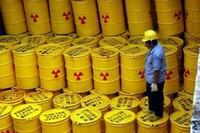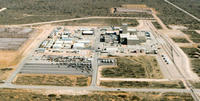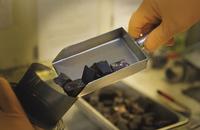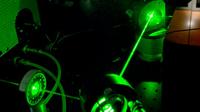-
Mustard plants help detect use of chemical weapons
Making nations comply with the Chemical Weapons Convention requires that scientists can accurately detect the use of chemical warfare agents. Currently they carry out tests on soil from areas where use is suspected. Many nerve agents composed of organo-phosophorous compounds, however, leach from soil over time, removing the evidence of use and making verifying the deployment of chemical weapons like sarin, soman, and VX difficult. Researchers report that white mustard plants can help by allowing detection for up to forty-five days after the chemical weapons were used.
-
-
Cesium chloride blood irradiators increase dirty bomb risk
Federal officials want to halt the use of blood irradiators used by hospitals and blood centers to ensure that blood is properly treated before transfusions occur. The irradiation devices contain cesium chloride, a highly radioactive powder which terrorists could use to make a dirty bomb. A 2008 reportby the National Academy of Sciences recommended stopping the licensing of new cesium chloride radiation sources, thereby encouraging the adoption of alternative sources with a less dispersible form of radioactive cesium, including cobalt-60 or X-ray irradiators.
-
-
Safety of nuclear waste storage questioned

The aftermath of the Hiroshima and Nagasaki bombings, and the Chernobyl accident, offers proof that high doses of radiation can have pernicious effects on plant and animal life. The largest human-made radiation risk, however, lies in nuclear waste stored near reactors or in underground repositories like the Waste Isolation Pilot Plant(WIPP) in Carlsbad, New Mexico.
-
-
Converting light to sound for better weapons detection, medical imaging
A device that essentially listens for light waves could help open up the last frontier of the electromagnetic spectrum — the terahertz range. So-called T-rays, which are light waves too long for human eyes to see, could help airport security guards find chemical and other weapons. They might let doctors image body tissues with less damage to healthy areas. They could also give astronomers new tools to study planets in other solar systems. Those are just a few possible applications.
-
-
New Mexico demands clarifications, reassurances on WIPP radiation leaks

New Mexico’s environment secretary Ryan Flynn has ordered the Department of Energy (DOE) to explain how it will protect public health and the environment while it investigates a radiation leak at the underground Waste Isolation Pilot Plant (WIPP). The plant has not been in compliance with various permit requirements since the February underground fire and radiation leak, which eventually led to a plant shutdown.
-
-
Problems continue to plague the Oxide Conversion Facility at Y-12

Oxide conversion is critical to recycling weapons-grade uranium, making it useful in nuclear warheads or for other purposes. The Oxide Conversion Facility (OCF) at the Y-12National Security Complex has been operating inconsistently in recent years. A report by the staff of the Defense Nuclear Facilities Safety Board(DNFSB) said there was a plan to resume operations the week of 7 April 2014, but that did not happen.
-
-
Absorbent used in kitty litter may be cause of radiation leaks in U.S. nuke dump
A wheat-based absorbent often used in kitty litter may be the likely cause of the radiation leak that led to the closure of the Waste Isolation Pilot Plant(WIPP), the U.S. only underground nuclear waste repository, according to Jim Conca, a former geochemist at Los Alamos National Laboratory(LANL). Conca noted that EnergySolutions, a Salt Lake City-based company hired to package radioactive waste at LANL into containers for shipment to the WIPP, switched from using a clay-based absorbent in the storage drums to a wheat-based mixture.
-
-
Lawmakers want safer waste storage at nuclear plants
Lawmakers on Tuesday introduced a set of bills aimed at improving the safety and security of nuclear power plants’ waste in the event of a natural disaster or terrorism. One of the bills would require nuclear power plant operators to accelerate the transfer of nuclear waste stored in spent fuel pools into dry cask storage units. Current Nuclear Regulatory Commission(NRC) regulations allow spent fuel to remain in spent fuel pools until the reactor completes decommissioning, which can take as long as sixty years. Another bill would stop the NRC from issuing exemptions to its emergency response and security requirements for reactors that have been permanently decommissioned.
-
-
Leaders of Chinese city delay alerting residents to deadly radiation risk
Authorities in the East China city of Nanjing delayed,for thirty-six hours, notifying residents about the loss of deadly isotope iridium-192 pellets at a local industrial plant. The pellets disappeared on Wednesday, and plant officials informed government authorities on Thursday – but did not inform city residents until Saturday. The extremely toxic pellets, the size of beans, were found the following Saturday in an open field one kilometer from the plant. The plant management detained four employees at the plant on Sunday for violating radioactive work regulations and storage rules, and they are likely to face criminal charges.The plant is using the isotope to find flaws in metal components.
-
-
Bolstering shipping security
During a press conference following the March 2014 Nuclear Security Summit in the Hague, President Barack Obama noted that his biggest security concern was not Russia — or any other regional superpower — but rather “the prospect of a nuclear weapon going off in Manhattan.” Experts say that the most likely way in which a nuclear weapon would potentially come to a major U.S. city is not on the tip of a missile but in the belly of a ship, noting that this view has been openly validated by the intelligence community. In 2007, Congress passed a law requiring all overseas cargo containers to be inspected before they are loaded on a U.S.-bound ship. That law, however, has never been enforced.
-
-
Validating air sampling techniques to fight bioterrorism
Air and surface sampling techniques currently used by the U.S. government are effective in fighting bioterrorism and potentially saving lives, a new study says. Air sampling has been readily accepted for similar uses such as measuring for particulate matter, but using it to detect bacteria in biological terrorism was a new concept instituted after the 9/11 attacks. This type of sampling is now part of a sophisticated system used by the DHS and the Department of Defense. In order for the system to work more efficiently, however, experts say that the detection cycle, which currently takes between 12-36 hours, would need to produce results in a shorter time frame.
-
-
Battelle shows smart technology for biodefense and hazard avoidance
Battelle last week announced production of the next generation chemical and biological hazard sensor system, which the company says operates at a fraction of the cost of current technologies. The technology, known as the Resource Effective BioIdentification System (REBS), is a battery-powered system capable of autonomous use with operating costs of less than $1 per day per unit (the company notes that current system costs that can range from $500 - $3,000 per day) and assay costs of $0.04 per sample (compared to current systems at over $100 per sample).
-
-
Using light to detect trace amounts of explosives

Researchers may help in the fight against terrorism with the creation of a sensor that can detect tiny quantities of explosives with the use of light and special glass fibers. The researchers describe a novel optical fiber sensor which can detect explosives in concentrations as low as 6.3 ppm (parts per million). It requires an analysis time of only a few minutes.
-
-
South Carolina withdraws MOX lawsuit against DOE, NNSA
The state of South Carolina said Friday that it would not go ahead with its lawsuit against the Department of Energy and the National Nuclear Security Administration (NNSA) in support of the Savannah River Site’s Mixed Oxide (MOX) Fuel Fabrication Facility. The dismissal of the lawsuit follows an announcement last Tuesday by the DOE and NNSA that construction will continue on the MOX facility through the end of the fiscal year. The two agencies made it clear, though, that they still plan to mothball the plant.
-
-
Lawmakers want DOE to reduce run-away costs of S.C. plutonium processing plant
Lawmakers have given the Obama administration two weeks to submit a plan for reducing the cost of constructing the mixed-oxide fuel conversion (MOX) facility which would convert bomb-grade plutonium into nuclear fuel. The MOX facility at the Savannah River Site, South Carolina was launched to help the United States meet its nuclear arms reduction agreement with Russia, and agreement which called for the two countries to dispose of at least thirty-four metric tons each of weapons-grade plutonium.
-
More headlines
The long view
Keeping the Lights on with Nuclear Waste: Radiochemistry Transforms Nuclear Waste into Strategic Materials
How UNLV radiochemistry is pioneering the future of energy in the Southwest by salvaging strategic materials from nuclear dumps –and making it safe.
Model Predicts Long-Term Effects of Nuclear Waste on Underground Disposal Systems
The simulations matched results from an underground lab experiment in Switzerland, suggesting modeling could be used to validate the safety of nuclear disposal sites.
